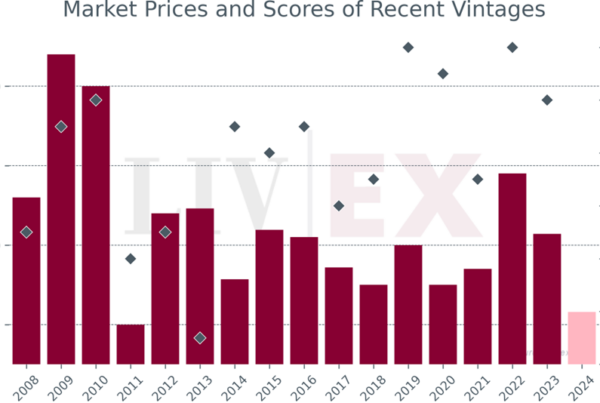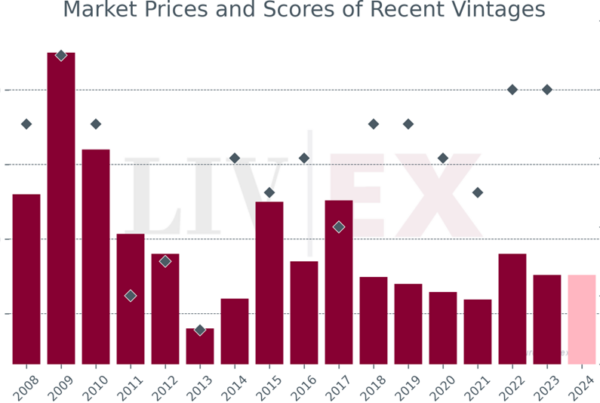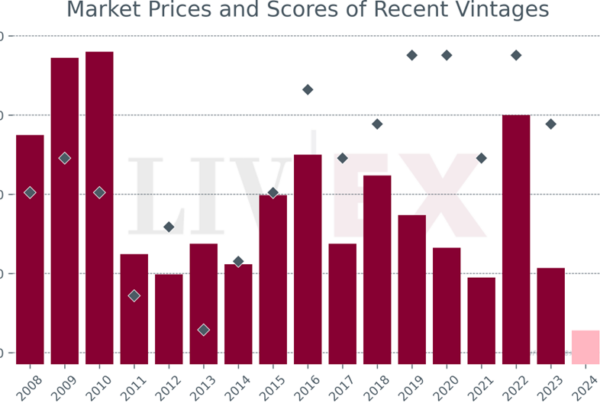With Chinese New Year on the horizon, we take a look at eight lucky fine wines whose names take on whole different meaning when written in Chinese characters.
酩悦Moet & Chandon: happy drinking
Moet and Chandon reads happy drinking, and few in possession of a glass of Champagne are likely to disagree.
It is not often that Jancis Robinson awards a perfect 20/20, but the acclaimed Dom Perignon 2002 was deemed worthy of her praise. She noted that it “really reaches every hidden cell of the palate” and suggested it may represent LVMH at its very best.
Presumably the buyers of these imperials at around £3,600 per 600cl (equivalent £4,500 per 12×75) agree.
奔富Penfolds: getting rich
Penfolds Grange is the most active Australian wine on the secondary market, accounting for around 40% of the region’s share by value last year. It was also one of just two labels from Australia to be classified as a First Growth in Liv-ex’s 2017 global classification (with Henschke Hill of Grace).
Over the past year, recent vintages of Grange have risen by an average of 6.4%, underperforming the Rest of the World 50 index (+10.45%) of which it is a component, though not terribly.
So while you might need to be rich to acquire Grange, investing in it might not have helped you get rich – at least as much as other collectable wines.
老色丹Vieux Chateau Certan: elders look rosy and happy
The Chinese translation of Vieux Chateau Certan (and this author’s personal favourite), 老色丹, means elders look rosy and happy.
This is certainly true when you look at some of the estate’s very old wines. The famous 1945 scores 98-100 from Robert Parker and the 1948 received 98 points.
However, perhaps ironically given the Chinese meaning, scores for this Pomerol Chateau have been climbing since the early 1990s when Alexandre Thienpont took hold of the estate. Young vintages such as the 2015, awarded 98-100 by Neal Martin, look particularly rosy. Martin called it, “a beguiling Pomerol that will set hearts aflutter…”
嘉雅Gaja: precious and elegant
Gaja is precious and elegant according to Chinese characters and many tasters. The brand’s Sori San Lorenzo was the second ranked Italian wine after Masseto in last year’s Liv-ex Classification with an average trade price of £2,005 per 12×75.
The brand was ranked in 56th place in the 2017 Power 100, down from 47 the previous year. With its broad portfolio, it performed particularly well in the category for unique wines traded, ranking in 15th place.
 活灵魂Almaviva: living soul
活灵魂Almaviva: living soul
Chilean Almaviva translates as living soul both from Spanish to English and when written in Chinese characters.
Its critically acclaimed 2015 vintage was released last year. James Suckling awarded it a perfect 100 points, describing it as, “so balanced and harmonious”. Writing for JancisRobinson.com, Richard Hemming scored it 17.5/20. He called it “far more satisfying than plenty of Bordeaux 2015s!”
It was Chile’s highest-ranking wine in the Liv-ex 2017 Classification, finding a place among the ‘second growths’ of the world.
美讯Mission Haut-Brion: good news
When written in Chinese characters, Mission Haut Brion means, literally, good news. Unfortunately for collectors of the wine, its performance has not always lived up to its name. Over a ten year period, it has considerably underperformed the Bordeaux 500. Mission has gained just 13.2% compared to the wider index’s 63.7%.
Since the market’s recent low, however, Mission has been level pegging with the Bordeaux 500. Both are up 34.7% since June 2014.
麒麟酒庄Chateau Kirwan: kyrin; unicorn
When pronounced in Chinese, Kirwan (Kyrin) sounds like unicorn. Unfortunately any attempt at linking this estate to a horned mythical creature would be tenuous at best, so please enjoy this simple chart of its prices and scores. We note that recent vintages look comparatively favourable for buyers.
宝嘉龙 Ducru Beaucaillou: precious dragon
Ducru Beaucaillou is the precious dragon. Its index has taken flight in the past decade, outperforming the Bordeaux 500. It is up 130% compared to the wider index’s move of 64%.
[mc4wp_form id=”18204″]










